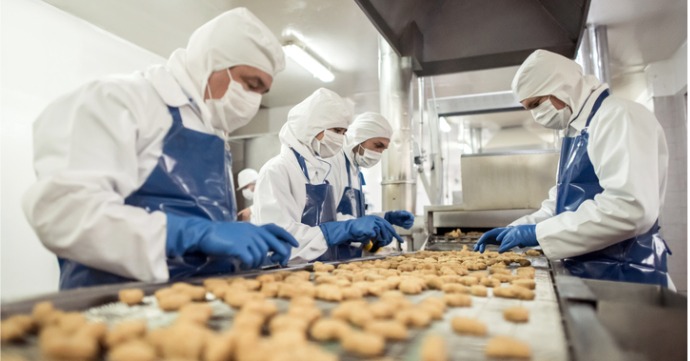
Not many people associate personal protective equipment (PPE) with the food industry because the role of PPE might be a little different in commercial kitchens than in construction sites. PPE can play a dual role in keeping food safe and protecting workers. Continue reading on how different PPE items are essential in the food industry.
What is PPE?
Personal Protective Equipment (PPE) is equipment workers wear to minimise exposure to hazards that cause injuries and illnesses in the workplace. The risks can result from contact with chemical, radiological, mechanical, or physical elements.
What PPE is Used For in the Food Industry
PPE worn by workers in the food industry can include:
- Gloves
- Safety glasses
- Masks
- Hairnets
- Overalls
- Face shields
- Shoe covers
- Ear plugs
Keeping Food Safe with PPE
Food contamination in production facilities is one of the highest risks to food manufacturing companies. One incident can cost millions in recalled products, and a brand’s reputation. Many companies worldwide have not survived following a single food contamination incident.
Food can become contaminated by workers or the environment. The good news is ensuring the facility is kept clean can reduce the environmental risks, and PPE can reduce the risk of a worker unwittingly contaminating the food product.
Gloves
Our fingers are covered in bacteria, which can spread and result in a wide range of infections and illnesses when bare hands handle food. Food handling workers can reduce the risks by washing their hands constantly and covering them with disposable gloves to ensure the bacteria doesn’t transfer from hands to food.
Employees are advised to change gloves after 4 hours of continuous use or replace them immediately if the glove is torn or contaminated. If a worker completes tasks other than food preparation, such as cleaning, one must replace the gloves.
Likewise, the same pair cannot be used for handling ready-to-eat and raw food.
Face Mask
Wearing a face mask reduces multiple risks of food contamination. Sneezing or coughing creates respiratory droplets that can spread respiratory viral infections. Wearing a face mask ensures most of these droplets are contained. A face mask or beard net also covers facial hair, which can fall off a worker and contaminate food.
Hairnet
Some food preparation workplaces require all workers to wear a hairnet, no matter the length of their hair. The hairnet helps stop stray hairs and shedding scalp skin from falling into food. Other workplaces allow staff to wear their hair tucked under a hat.
Overalls
Wearing overalls supplied by the employer means personal clothing from outside the facility doesn’t come into contact with the food. Employees' own clothing can be covered in pet fur, pollen, smoke particles, dust, and bacteria. Supplying overalls allows the company to control the cleanliness of clothing entering the manufacturing facility.
Shoe Covers
Shoes are covered in bacteria. Wearing street shoes in a food facility is a recipe for possible food contamination. If workers cover their shoes with a disposable bootie (shoe cover), there is a barrier between the shoe and items in the manufacturing facility.
Keeping Workers Safe with PPE
Food industry workers are at risk of a number of injuries, including slips and trips, injuries from machinery and knives, high levels of noise, and harmful substances. With proper training and the right equipment, the risks of a commercial kitchen or food production facility are greatly reduced. Some PPE have dual jobs of keeping food safe from contamination while at the same time protecting the wearer.
Gloves
Wearing gloves when manufacturing some food products can keep workers safe from a number of risks. Cut-resistant gloves keep butchers and chefs safe from knife injuries. Thermal gloves protect workers from the extreme cold of frozen foods. Thick chemical gloves are ideal for those working with grease and oils. Abattoir workers are at high risk of illnesses so they may wear a thick, long-sleeved barrier between their skin and the meat products. Thin disposal gloves are worn by the majority of food preparation workers to protect their hands from food products and constant hand washing.
Ear plugs
Food manufacturing has one of the highest risks of hearing loss. Machinery that labels, fills bottles and cans, wraps, packages, and chills are some of the noisiest and most hazardous machines for hearing loss. By wearing noise-blocking ear plugs, the workplace is safer for workers to spend long periods.
Hairnets
Long hair and machinery are a bad combination in any industry, and food production is no exception. Long hair is not only a contamination risk but a risk to the worker if using machinery with moving parts that can ‘grab’ hair. A hairnet ensures that hair is contained so it can’t be caught.
Shoe Covers
Floors can quickly become slippery with food particles or liquids creating slip hazards. Wearing slip-resistant sole shoes can protect workers from slipping, but shoe covers with a non-slip sole will also provide protection.
Shoe-Inn cover dispensers make it safe for workers to put the covers over their shoes. Balancing on one foot while bending over places workers at unnecessary risk of falling and causing serious injury. The risk increases with a worker’s age when their balance is often not as good as it once was. Shoe cover application is also much faster with a dispenser.
Protective shoe covers and dispensers are perfect to improve safety in a range of industries, such as food production, and help keep surfaces free of bacteria. For more information, get in touch with Helix Solutions on 1300 29 32 32 or contact us online.